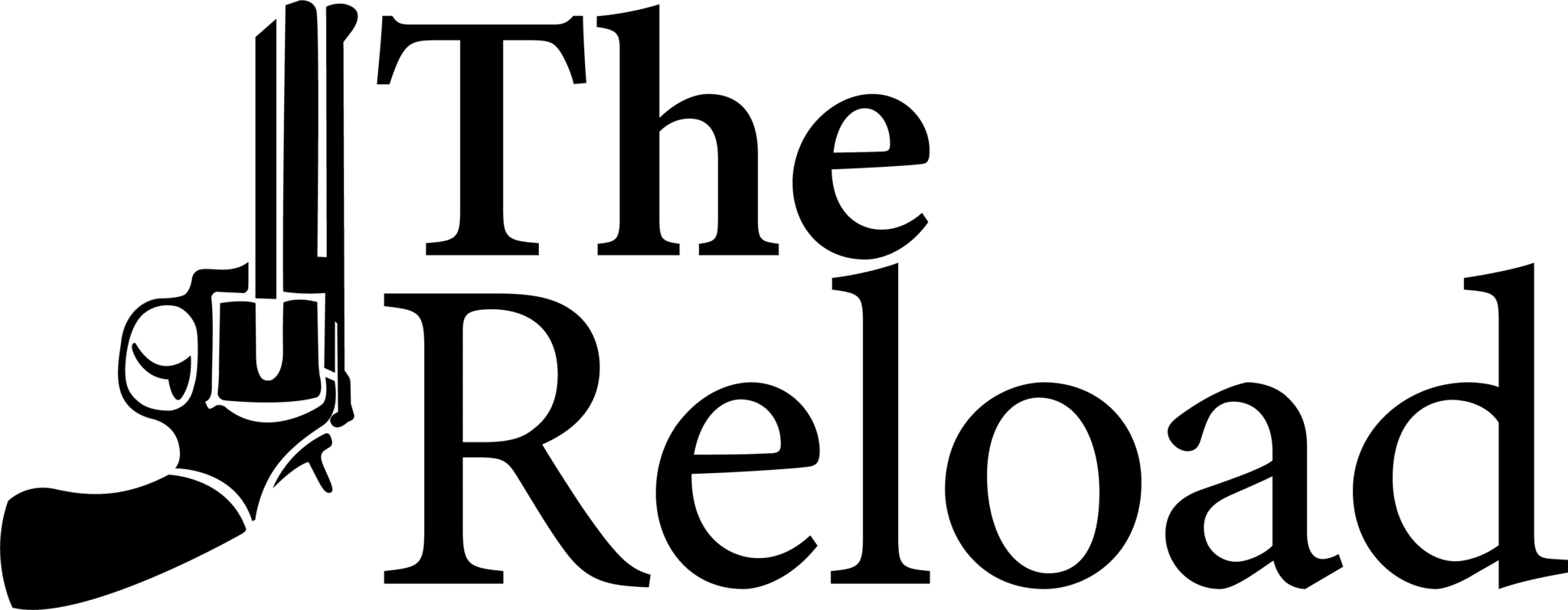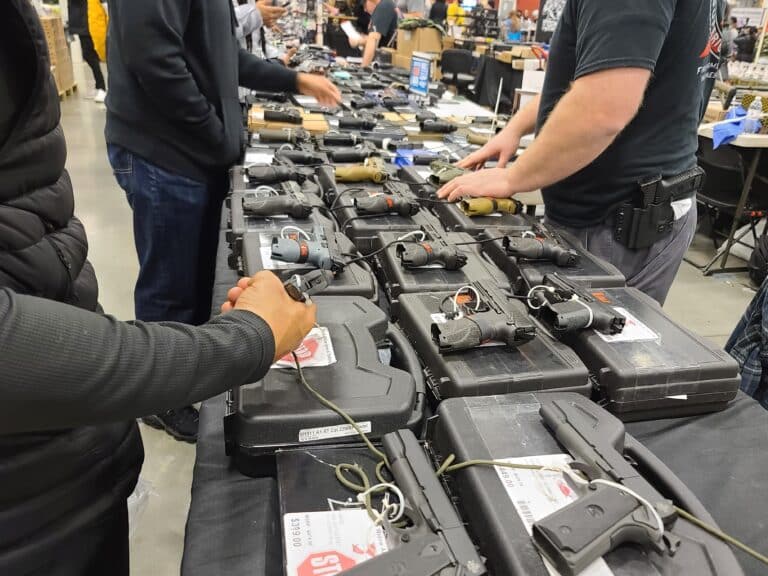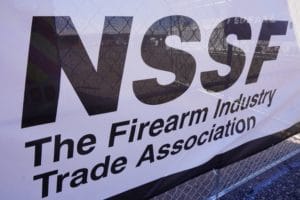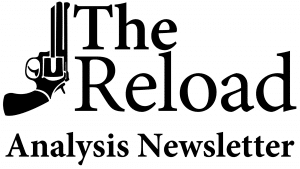American manufacturers dominate the gun industry, but that doesn’t mean it won’t feel the impact of President Donald Trump’s new tariffs.
American manufacturers produced 171,810,319 guns between 2000 and 2023, according to the ATF. The same data shows Americans imported 93,335,557 guns at the same time. A different ATF report found Americans imported 26 billion rounds of ammunition between 2010 and 2020 alone.
Despite issuing a 90-day pause on most of his tariffs, President Trump said on Wednesday he was still imposing a 10 percent tax across the board and increased the rate on Chinese imports to 145 percent. The gun industry’s trade association and several gun companies who recently spoke with The Reload said they’re concerned about where this is all headed.
While most of the gun companies The Reload reached out to did not comment on the tariffs, the industry’s representative warned increasing tariffs and a possible resulting trade war could have serious adverse effects. The National Shooting Sports Foundation (NSSF) said it couldn’t predict precisely what the impact would be in the near or mid-term, but it anticipated the downsides could be significant.
“NSSF is monitoring the current situation regarding the increase in tariffs being imposed by the United States on imported commodities and raw materials, e.g., copper, steel, aluminum, and on firearm, ammunition, optics and related products for the hunting, shooting and personal protection market,” the group told The Reload. “NSSF is also monitoring countervailing tariffs being imposed or threatened by other countries.”
It warned the tariffs may force companies to raise prices for guns, ammo, and accessories.
“NSSF is concerned that the growing ‘trade war’ will result in increased manufacturing costs, which could adversely impact profitability and economic growth for our industry,” the group said. “We are also concerned that prices will increase at the wholesale and retail level for both imported and domestically manufactured firearms, ammunition and related products, which could lead to a reduced consumer demand and exacerbate an already soft market. Rising tariffs will also constrict the export market for our industry’s products.”
NSSF was not alone in predicting prices would rise under the new tariffs, which still exceed the levels of those imposed during the great depression. Lucky Gunner, one of the nation’s leading online ammunition dealers, expects costs to go up. But, like NSSF, it can’t predict by how much.
“The long-term impact of the tariffs is very fuzzy,” Anthony Welsch, a Lucky Gunner spokesman, told The Reload. “Our purchasing team has good relationships with importers and foreign manufacturers. Many of them believe price increases are coming soon. However, it’s very difficult to pinpoint exactly what the increases will be.”
Ben Beauchemin, the owner of Wicked Weaponry, said he’s worried about what lies ahead.
“With everything’s going on, we are waiting with bated breath just to see what’s going to happen,” he told The Reload. “We’re not exactly sure how that’s going to trickle down to us, but at least I know our aluminum products went up–in some cases by about five or ten percent. It’s tough to tell what the cause of that was, but everything is creeping up.”
Sam Gabbert, owner of Oklahoma-based online ammo dealer SGAmmo, agreed.
“In short, it is going to drive up prices for the consumer in a dramatic way and totally cut off supply in certain brands over time,” he wrote in a message to customers.
Welsch said some of their most popular ammo brands are made overseas, and they stand to take a beating under Trump’s plan–especially if they’re hit with higher tariffs after the pause expires in July.
“For example, we carry and sell a lot of PMC ammo that’s made in South Korea,” he said. “Under President Trump’s plan, that country faces a 25% tariff. The ammo game isn’t a high margin market so we don’t expect the manufacturer will be able to absorb all that tariff. If the company anticipates it’s a short term situation, maybe they can absorb a portion of it but it’s not reasonable to think they can take a 25% hit on their wholesale price. It seems inevitable we’ll be paying more for ammo. In order to stay around, retailers will have to increase prices. In turn, American shooters will likely be paying more for rounds.”
Even with the “paused” rate dropping to 10 percent for most countries, American consumers will still likely feel the impact. Gabbert pointed out that the lower rate could still add noticeable cost to imported ammo.
“Magtech in Brazil was hit with the smallest tariff at 10%, but still substantial to drive 9mm prices up $20 or so per 1000 rounds,” he wrote.
Gun accessory manufacturers could get hit even worse. Welsch noted many optic and apparel brands produce their products in China or other parts of Southeast Asia, where Trump has levied the highest tariffs.
“I imagine some firearm-adjacent companies that are primarily in textiles are sweating even more than ammo/firearms,” he said.
It hasn’t been all bad news so far, though. Lucky Gunner noted demand has spiked significantly this week and SGAmmo’s website currently warns customers of longer-than-usual wait times due to “extremely high order volume.”
“We’re already seeing an impact from the new tariffs,” Welsch said. “Since ‘Liberation Day,’ shooters are absolutely buying more ammo. Sales are up about 50 percent when comparing the past four days to the week prior.”
Additionally, most of the industry is based in America and will likely avoid the brunt of the tariffs. That could make their products more competitive as a result–certainly that’s what President Trump is banking on. However, Welsch warned the tariffs will probably increase costs for domestic producers as well.
“We know that the guys producing rounds in the United States are sourcing components and raw materials from overseas,” he said. “Because of that, it seems very likely American-made ammo prices will increase too. Most manufacturers keep their supply chains pretty close to the vest, so it’s hard to say specifically how their cost structure will change, but it’s reasonable to expect increases here as well.”
Beauchemin’s New Hampshire shop and boutique gun maker also uses almost exclusively American-made components in their builds. But he isn’t confident that will keep them from having to raise prices if his suppliers do the same.
“Most of our stuff is USA-made. So, my hope is that stuff won’t be affected,” he said. “But that doesn’t necessarily mean that the raw materials are all from the US, either.”
He said he’s going to do everything to keep costs and prices down, but there’s not a lot of margin on gun sales to begin with.
“We’re getting a lot of conversations with our sales reps that everybody’s trying to do everything to keep prices down, but at the end of the day, they have to keep the doors open too. So, same thing for us,” Beauchemin said. “It seems like it’s going to trickle down to the customers.”
He noted the tariffs come at a bad time for his company and the industry overall. Sales have been slumping since last year, and prices have already been increasing from a number of other factors, such as inflation.
“A lot of companies have been creeping up the prices pretty steadily, even before the tariffs,” Beauchemin said. “Normally, in an election cycle, we’d see a huge uptick before the election and after. Even with stuff like holiday shopping and Black Friday, we were absolutely down. We were down approximately 30% in gross sales for the year.”
He said he’d never seen a downturn quite like this one and has shifted some of his efforts away from gun making or dealing and toward service work, like gunsmithing and cerakoting, to try and make up the difference.
“I’ve been doing it for 13 years, and this is the quietest year we’ve ever had,” Beauchemin said. “I don’t know how it was industry-wide, but it really sounded like everybody was in the same boat.”
Gabbert predicted that if the tariffs revert to their initial level after the pause, they could kill off many imported brands in remarkably short order while still harming American makers in the long run.
“In my opinion, unless the tariffs are reversed or reduced to much lower levels, the most likely course for where we are at is that many of the import ammo brands are driven out of business in 6 months to a year or are forced to charge unrealistic prices that very few consumers will pay, shrinking their volume to an unsubstantial point.” he wrote. “At the same time, US manufacturing most likely slowly raises prices 3% to 8% once each quarter of remaining 2025 and early 2026, pushing prices up to match import competitors on the most popular calibers like 9mm, 45 auto and 5.56 / 223 and more, where profit margins have been suffering due to price cuts over the past 2 years while also dealing with continuous upward movements in manufacturing costs.”
Bauchemin was less sure about how things might turn out under Trump’s tariffs, but he agreed the outlook seemed grim.
“I don’t see any way in which pushing tariffs is helpful in the short term,” he told The Reload. “Certainly, I’m not an economist, so I can’t talk about the long game, but the world is buckling up for more harm than good as far as what we’re seeing.”






